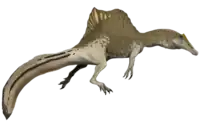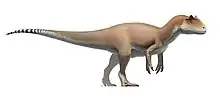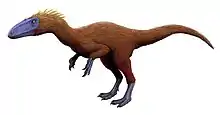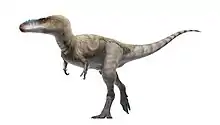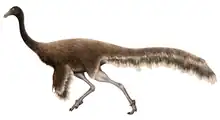| Genusaurus Temporal range: Early Cretaceous, | |
|---|---|
| Scientific classification | |
| Domain: | Eukaryota |
| Kingdom: | Animalia |
| Phylum: | Chordata |
| Clade: | Dinosauria |
| Clade: | Saurischia |
| Clade: | Theropoda |
| Clade: | †Neoceratosauria |
| Superfamily: | †Abelisauroidea |
| Genus: | †Genusaurus Accarie et al., 1995 |
| Species: | †G. sisteronis |
| Binomial name | |
| †Genusaurus sisteronis Accarie et al., 1995 | |
Genusaurus (/ˌdʒɛnjʊˈsɔːrəs/ JEN-yuu-SOR-əs;[1] meaning "knee lizard") is a genus of abelisauroid dinosaur from the Early Cretaceous. Its fossils were found in France. Genusaurus is believed to have lived during the Albian stage, around 112-100 million years ago.[2][3]
Description
Genusaurus possesses several distinguishing traits. The dorsal vertebrae are elongated. The elements of the pelvis are strongly fused. The thighbone shows a low bone plateau below the major trochanter; to the front an accessory trochanter is present. The epicondyle of the inner femoral condyle is well-developed. The cnemial crest strongly extends to the front and is curved upwards. The fibula has a distinctive boss serving as an attachment for the Musculus iliofibularis. The upper inner side of the fibula is strongly hollowed out.[4]
Size
Genusaurus was originally estimated to have been 3.16 metres (10.4 ft) long. From the 38 centimetres (15 in) thighbone, a weight of 129.6 kilograms (286 lb) was extrapolated.[4] Later estimates, while confirming the length of 3 metres (9.8 ft),[2] have reduced the weight to 50 kilograms (110 lb),[5] or even 35 kilograms (77 lb).[6] In 2016, its length was estimated at 3.6 metres (12 ft), making it the smallest abelisaurid.[7]
Discovery and naming
The type species, Genusaurus sisteronis, is the only named species. It is based on a partial skeleton found in 1984-1986 in the Albian Bevons Beds, holotype MNHN Bev.1. The holotype contains seven partial dorsal vertebrae, a piece of a sacral, a piece of an ilium, the top of a pubic bone, a thighbone, the top of a shinbone, the top of a fibula and a metatarsal. It was named and described by Hugues Accarie, Bernard Beaudoin, Jean Dejax, Gérard Friès, Jean-Guy Michard and Philippe Taquet in 1995.[4] The genus name is derived from the Latin word genu (knee) and refers to the cnemial crest in front of the proximal end of the tibia.[4] The specific name refers to Sisteron, the town near which the specimen was found.[4]
Classification
Accarie et al. assigned Genusaurus to the ceratosaur group of theropods, more precisely to the Coelophysoidea.[4] A 2008 cladistic analysis by Carrano and Sampson placed Genusaurus in the Noasauridae along with Laevisuchus, Masiakasaurus, Noasaurus, and Velocisaurus; in turn, noasaurids are part of the Abelisauroidea group, which is part of the ceratosaur group.[3] Subsequent phylogenetic analyses found Genusaurus to be a member of the Abelisauridae, specifically the Majungasaurinae.[8]
See also
References
- ↑ Creisler, Ben (July 7, 2003). "Dinosauria Translation and Pronunciation Guide G". Archived from the original on December 25, 2010. Retrieved December 7, 2012.
- 1 2 Holtz, Thomas R. Jr. (2007). Dinosaurs: The Most Complete, Up-to-Date Encyclopedia for Dinosaur Lovers of All Ages. Genus list "last updated 8/1/2008". New York: Random House. ISBN 978-0-375-82419-7.
{{cite book}}: External link in|others= - 1 2 Carrano, Matthew T.; Sampson, Scott D. (2007). "The Phylogeny of Ceratosauria (Dinosauria: Theropoda)" (PDF). Journal of Systematic Palaeontology. 6 (2): 183–236. doi:10.1017/S1477201907002246. S2CID 30068953.
- 1 2 3 4 5 6 Accarie, H., B. Beaudoin, J. Dejax, G. Fries, J.C. Michard, and P. Taquet (1995). "Découverte d'un Dinosaure théropode nouveau (Genusaurus sisteronis n. g., n. sp.) dans l'Albien marin de Sisteron (Alpes de Haute-Provence, France) et extension au Crétacé inférieur de la lignée cératosaurienne". Compte rendu hebdomadaire des scéances de l'Académie des Sciences à Paris. 320 (2): 327-334 Translation into English.
- ↑ Montague, J. R. (2006). "Estimates of body size and geological time of origin for 612 dinosaur genera (Saurischia, Ornithischia)". Florida Scientist. 69 (4): 243–257.
- ↑ Paul, G.S., 2010, The Princeton Field Guide to Dinosaurs, Princeton University Press p. 78
- ↑ Grillo, O. N.; Delcourt, R. (2016). "Allometry and body length of abelisauroid theropods: Pycnonemosaurus nevesi is the new king". Cretaceous Research. 69: 71–89. doi:10.1016/j.cretres.2016.09.001.
- ↑ Leonardo S. Filippi; Ariel H. Méndez; Rubén D. Juárez Valieri; Alberto C. Garrido (2016). "A new brachyrostran with hypertrophied axial structures reveals an unexpected radiation of latest Cretaceous abelisaurids". Cretaceous Research. 61: 209–219. doi:10.1016/j.cretres.2015.12.018.
External links
- "Our Exhibitions: Genusaurus sisteronis" (in French) at the Réserve Naturelle Géologique de Haute-Provence, France.
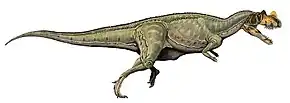
.jpg.webp)


